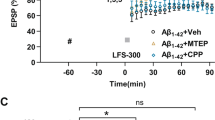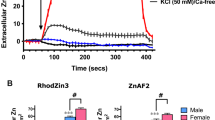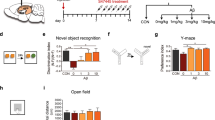Abstract
Amyloid plaque is the hallmark and primary cause of Alzheimer disease. Mutations of presenilin-1, the γ-secretase catalytic subunit, can affect amyloid-β (Aβ) production and Alzheimer disease pathogenesis. However, it is largely unknown whether and how γ-secretase activity and amyloid plaque formation are regulated by environmental factors such as stress, which is mediated by receptors including β2-adrenergic receptor (β2-AR). Here we report that activation of β2-AR enhanced γ-secretase activity and thus Aβ production. This enhancement involved the association of β2-AR with presenilin-1 and required agonist-induced endocytosis of β2-AR and subsequent trafficking of γ-secretase to late endosomes and lysosomes, where Aβ production was elevated. Similar effects were observed after activation of δ-opioid receptor. Furthermore, chronic treatment with β2-AR agonists increased cerebral amyloid plaques in an Alzheimer disease mouse model. Thus, β2-AR activation can stimulate γ-secretase activity and amyloid plaque formation, which suggests that abnormal activation of β2-AR might contribute to Aβ accumulation in Alzheimer disease pathogenesis.
This is a preview of subscription content, access via your institution
Access options
Subscribe to this journal
Receive 12 print issues and online access
$209.00 per year
only $17.42 per issue
Buy this article
- Purchase on SpringerLink
- Instant access to full article PDF
Prices may be subject to local taxes which are calculated during checkout






Similar content being viewed by others
References
Tanzi, R.E. The synaptic Aâ hypothesis of Alzheimer disease. Nat. Neurosci. 8, 977–979 (2005).
Cleary, J.P. et al. Natural oligomers of the amyloid-β protein specifically disrupt cognitive function. Nat. Neurosci. 8, 79–84 (2005).
Takasugi, N. et al. The role of presenilin cofactors in the γ-secretase complex. Nature 422, 438–441 (2003).
Sisodia, S.S. & St. George-Hyslop, P.H. γ-secretase, Notch, Aβ and Alzheimer's disease: where do the presenilins fit in? Nat. Rev. Neurosci. 3, 281–290 (2002).
Tanzi, R.E. & Bertram, L. Twenty years of the Alzheimer's disease amyloid hypothesis: a genetic perspective. Cell 120, 545–555 (2005).
Koo, E.H. & Kopan, R. Potential role of presenilin-regulated signaling pathways in sporadic neurodegeneration. Nat. Med. 10 (suppl.), S26–S33 (2004).
Cai, D. et al. Presenilin-1 uses phospholipase D1 as a negative regulator of β-amyloid formation. Proc. Natl. Acad. Sci. USA 103, 1941–1946 (2006).
Weggen, S. et al. A subset of NSAIDs lower amyloidogenic Aβ42 independently of cyclooxygenase activity. Nature 414, 212–216 (2001).
Nitsch, R.M., Slack, B.E., Wurtman, R.J. & Growdon, J.H. Release of Alzheimer amyloid precursor derivatives stimulated by activation of muscarinic acetylcholine receptors. Science 258, 304–307 (1992).
Xu, H. et al. Estrogen reduces neuronal generation of Alzheimer β-amyloid peptides. Nat. Med. 4, 447–451 (1998).
Lazarov, O. et al. Environmental enrichment reduces Aβ levels and amyloid deposition in transgenic mice. Cell 120, 701–713 (2005).
Saito, T. et al. Somatostatin regulates brain amyloid β peptide Aβ42 through modulation of proteolytic degradation. Nat. Med. 11, 434–439 (2005).
Bierhaus, A. et al. A mechanism converting psychosocial stress into mononuclear cell activation. Proc. Natl. Acad. Sci. USA 100, 1920–1925 (2003).
Yin, D., Tuthill, D., Mufson, R.A. & Shi, Y. Chronic restraint stress promotes lymphocyte apoptosis by modulating CD95 expression. J. Exp. Med. 191, 1423–1428 (2000).
Ferry, B., Roozendaal, B. & McGaugh, J.L. Role of norepinephrine in mediating stress hormone regulation of long-term memory storage: a critical involvement of the amygdala. Biol. Psychiatry 46, 1140–1152 (1999).
Hall, R.A. & Lefkowitz, R.J. Regulation of G protein-coupled receptor signaling by scaffold proteins. Circ. Res. 91, 672–680 (2002).
Jordan, B.A., Trapaidze, N., Gomes, I., Nivarthi, R. & Devi, L.A. Oligomerization of opioid receptors with β2-adrenergic receptors: a role in trafficking and mitogen-activated protein kinase activation. Proc. Natl. Acad. Sci. USA 98, 343–348 (2001).
Gonzalez-Gaitan, M. & Stenmark, H. Endocytosis and signaling: a relationship under development. Cell 115, 513–521 (2003).
Shenoy, S.K. et al. β-arrestin-dependent, G protein-independent ERK1/2 activation by the β2 adrenergic receptor. J. Biol. Chem. 281, 1261–1273 (2006).
Gabilondo, A.M. et al. A dileucine motif in the C terminus of the β2-adrenergic receptor is involved in receptor internalization. Proc. Natl. Acad. Sci. USA 94, 12285–12290 (1997).
Seachrist, J.L. & Ferguson, S.S.G. Regulation of G protein-coupled receptor endocytosis and trafficking by Rab GTPases. Life Sci. 74, 225–235 (2003).
Russo-Neustadt, A. & Cotman, C.W. Adrenergic receptors in Alzheimer's disease brain: selective increases in the cerebella of aggressive patients. J. Neurosci. 17, 5573–5580 (1997).
Wang, Y.P., Wang, Z.F., Zhang, Y.C., Tian, Q. & Wang, J.Z. Effect of amyloid peptides on serum withdrawal-induced cell differentiation and cell viability. Cell Res. 14, 467–472 (2004).
Walter, J., Kaether, C., Steiner, H. & Haass, C. The cell biology of Alzheimer's disease: uncovering the secrets of secretases. Curr. Opin. Neurobiol. 11, 585–590 (2001).
Pinnix, I. et al. A novel γ-secretase assay based on detection of the putative C-terminal fragment-γ of amyloid β protein precursor. J. Biol. Chem. 276, 481–487 (2001).
Farmery, M.R. et al. Partial purification and characterization of γ-secretase from post-mortem human brain. J. Biol. Chem. 278, 24277–24284 (2003).
Law, P.-Y., Wong, Y.H. & Loh, H.H. Molecular mechanisms and regulation of opioid receptor signaling. Annu. Rev. Pharmacol. Toxicol. 40, 389–430 (2000).
Gagnon, A.W., Kallal, L. & Benovic, J.L. Role of clathrin-mediated endocytosis in agonist-induced down-regulation of the β2-adrenergic receptor. J. Biol. Chem. 273, 6976–6981 (1998).
Soeder, K.J. et al. The β3-adrenergic receptor activates mitogen-activated protein kinase in adipocytes through a Gi-dependent mechanism. J. Biol. Chem. 274, 12017–12022 (1999).
Seachrist, J.L. & Ferguson, S.S. Regulation of G protein-coupled receptor endocytosis and trafficking by Rab GTPases. Life Sci. 74, 225–235 (2003).
Gruenberg, J. The endocytic pathway: a mosaic of domains. Nat. Rev. Mol. Cell Biol. 2, 721–730 (2001).
Langui, D. et al. Subcellular topography of neuronal Aβ peptide in APPxPS1 transgenic mice. Am. J. Pathol. 165, 1465–1477 (2004).
Takahashi, R.H. et al. Oligomerization of Alzheimer's β-amyloid within processes and synapses of cultured neurons and brain. J. Neurosci. 24, 3592–3599 (2004).
Vetrivel, K.S. et al. Association of γ-secretase with lipid rafts in post-Golgi and endosome membranes. J. Biol. Chem. 279, 44945–44954 (2004).
Xia, W. et al. Presenilin complexes with the C-terminal fragments of amyloid precursor protein at the sites of amyloid β-protein generation. Proc. Natl. Acad. Sci. USA 97, 9299–9304 (2000).
Ray, W.J. et al. Evidence for a physical interaction between presenilin and Notch. Proc. Natl. Acad. Sci. USA 96, 3263–3268 (1999).
Li, Y.M. et al. Presenilin 1 is linked with γ-secretase activity in the detergent solubilized state. Proc. Natl. Acad. Sci. USA 97, 6138–6143 (2000).
Esler, W.P. et al. Activity-dependent isolation of the presenilin-γ-secretase complex reveals nicastrin and a gamma substrate. Proc. Natl. Acad. Sci. USA 99, 2720–2725 (2002).
Follesa, P. & Mocchetti, I. Regulation of basic fibroblast growth factor and nerve growth factor mRNA by β-adrenergic receptor activation and adrenal steroids in rat central nervous system. Mol. Pharmacol. 43, 132–138 (1993).
Guo, D.F., Sun, Y.L., Hamet, P. & Inagami, T. The angiotensin II type 1 receptor and receptor-associated proteins. Cell Res. 11, 165–180 (2001).
Vassar, R. β-secretase cleavage of Alzheimer's amyloid precursor protein by the transmembrane aspartic protease BACE. Science 286, 735–741 (1999).
Pasternak, S.H. et al. Presenilin-1, nicastrin, amyloid precursor protein, and γ-secretase activity are co-localized in the lysosomal membrane. J. Biol. Chem. 278, 26687–26694 (2003).
Cataldo, A.M. et al. Endocytic pathway abnormalities precede amyloid β deposition in sporadic Alzheimer's disease and Down syndrome: differential effects of APOE genotype and presenilin mutations. Am. J. Pathol. 157, 277–286 (2000).
Callahan, M.J. et al. Augmented senile plaque load in aged female β-amyloid precursor protein-transgenic mice. Am. J. Pathol. 158, 1173–1177 (2001).
Walters, M.R. & Sharma, R. Cross-talk between β-adrenergic stimulation and estrogen receptors: isoproterenol inhibits 17 β-estradiol-induced gene transcription in A7r5 cells. J. Cardiovasc. Pharmacol. 42, 266–274 (2003).
Fratiglioni, L., Paillard-Borg, S. & Winblad, B. An active and socially integrated lifestyle in late life might protect against dementia. Lancet Neurol. 3, 343–353 (2004).
Wilson, R.S. et al. Proneness to psychological distress is associated with risk of Alzheimer's disease. Neurology 61, 1479–1485 (2003).
Khachaturian, A.S. et al. Antihypertensive medication use and incident Alzheimer disease: the Cache County study. Arch. Neurol. 63, 686–692 (2006).
Ramsden, M. et al. Androgens modulate β-amyloid levels in male rat brain. J. Neurochem. 87, 1052–1055 (2003).
Bahadoran, P. et al. Characterization of the molecular defects in Rab27a, caused by RAB27A missense mutations found in patients with Griscelli syndrome. J. Biol. Chem. 278, 11386–11392 (2003).
Acknowledgements
We thank M.M. Poo, D.S. Li, H. Zheng, Z. Zhang and L. Pu for comments on the manuscript; Y.X. Zeng, G. Niu, P. Xia, Y.Y. Wang, W.B. Zhang and Y. Sun for technical support; R.J. Lefkowitz (Duke University Medical Center) for β2-AR TYY plasmid; S.L. Schmid (The Scripps Research Institute) for Dyn K44A plasmid; S. Marullo (The Cochin Institute) for β3-AR plasmid; P. Wang (University of Minnesota School of Medicine) for various Rab5 and Rab7 plasmids; and B. De Strooper (Katholieke Universiteit Leuven) and H.X. Xu (Burnham Institute for Medical Research) for wild-type and Psen1−/−Psen2−/− mouse embryonic fibroblasts. This research was supported by grants from the Ministry of Science and Technology (2003CB515405 and 2005CB522406) and the National Natural Science Foundation of China (30021003 and 30228018).
Author information
Authors and Affiliations
Contributions
This study was designed by Y.N., X.Z. and G.P. The experiments were performed by Y.N. and X.Z. G.B. and L.T. contributed to the in vivo experiments. L.Z. and Z.W. contributed to the in vitro experiments. M.S., J.X. and Y.B. provided the APPswe/PS1ΔE9 mice. G.P. supervised the project. Y.N., X.Z. and G.P. contributed to the writing of the paper.
Corresponding author
Ethics declarations
Competing interests
The authors declare no competing financial interests.
Supplementary information
Supplementary Fig. 1
Stimulation of endogenous DOR enhances γ-secretase activity. (PDF 138 kb)
Supplementary Fig. 2
Time course of γ-secretase activity after stimulation of β2AR. (PDF 260 kb)
Supplementary Fig. 3
Pertussis toxin does not affect DOR-induced enhancement of γ-secretase activity. (PDF 221 kb)
Supplementary Fig. 4
Transferrin can not induce γ-secretase activity enhancement. (PDF 230 kb)
Supplementary Fig. 5
Stimulation of DOR increases γ-secretase activity in LEL. (PDF 363 kb)
Supplementary Fig. 6
Stimulation of endogenous β2AR increases localization of γ-secretase components in LEL. (PDF 1320 kb)
Supplementary Fig. 7
Association of DOR and PS1 in rat hippocampus. (PDF 389 kb)
Rights and permissions
About this article
Cite this article
Ni, Y., Zhao, X., Bao, G. et al. Activation of β2-adrenergic receptor stimulates γ-secretase activity and accelerates amyloid plaque formation. Nat Med 12, 1390–1396 (2006). https://doi.org/10.1038/nm1485
Received:
Accepted:
Published:
Issue Date:
DOI: https://doi.org/10.1038/nm1485



